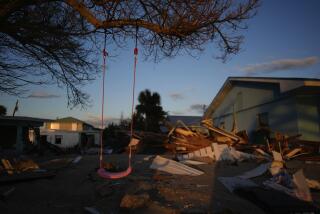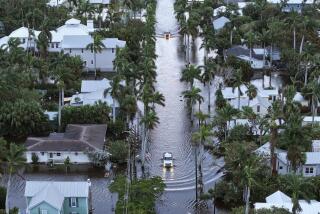Charley closes in as nearly 1 million told to evacuate
- Share via
Close to 1 million Florida residents and tourists were told Thursday to evacuate, as Hurricane Charley strengthens and churns toward the state’s Gulf Coast.
Charley is expected to pass west of the Keys early today before hitting southwest Florida with winds up to 120 mph, heavy rain, tornadoes and a dangerous storm surge, said Hugh Cobb, a meteorologist at the National Hurricane Center in Miami. Radar showed the first rain bands hitting the lower Keys Thursday night.
“This is a fairly sizable storm,” Cobb said. Hurricane-force winds extended outward up to 30 miles from the center, and tropical storm-force winds went out 125 miles.
At 5 a.m., the hurricane was in the Florida Straits, 85 miles west-southwest of Key West.Forecasters said Charley has top sustained winds of about 110 mph. It is moving north-northwest near 18 mph and is expected to strengthen, meteorologists said. Hurricane force winds extended outward 30 miles from the eye. Tropical storm force winds went out 125 miles. Charley is centered at 23.9 north latitude, 82.9 west longitude.
From the Keys to Tampa Bay, residents living along the coast or in low-lying areas were told to leave in anticipation of the hurricane’s arrival today. In Pinellas County alone, more than 380,000 people were told to flee -- more than a third of the county’s population -- in the biggest evacuation in the county’s history.
Gov. Jeb Bush, who already had declared a state of emergency, warned Floridians Thursday that Hurricane Charley could bring high winds, water and possible tornadoes to a large section of the state, from Tampa Bay to Orlando to Jacksonville.
“This looks like it has the potential to be the one we’ve all been warning about,” Bush said. “It’s going to swath through the state and could impact millions of people.”
Residents from the Tampa Bay area, where the eye is projected to hit, southward to the Naples area were told to expect a storm surge of 10-13 feet. State meteorologist Ben Nelson said the surge could reach up to 16 feet in the Tampa area if Charley hits at 120 mph.
“MacDill Air Force Base will probably be mostly underwater and parts of downtown Tampa could be underwater if we have a Category 3,” Nelson said. “In a Category 3, you can almost get to the point where Pinellas County becomes an island.”
In Orange County, officials worried the hurricane could spawn tornadoes in the Orlando area. Tropical Storm Bonnie, which came ashore Thursday, didn’t do much damage, but did spawn a tornado in the Jacksonville area.
“We’re fairly accurate at predicting hurricanes,” Orange Emergency Management Director Renzy Hanshaw said. “Where we’re not as accurate is predicting tornadoes.”
Orange officials said the hurricane’s impact could start to be felt in Orlando at 10 a.m. today, with winds at 40 mph or more. A tornado watch will be in effect as the storm moves over the area.
All of Central Florida’s school districts for today. Many residents and municipal workers also braced for the storm.
Also today, Orange County . No evacuation orders have been made in Orange County, but many Gulf Coast residents who have been ordered to evacuate are expected to flee the storm will likely head inland toward Orlando. The three shelters are for West Coast evacuees and any locals who may need emergency shelter.
The city of Oviedo offered its residents up to 10 free sandbags per person while workers in Polk County rushed to shore up construction work along a 27-mile stretch of Interstate 4. Across the region, schools pulled soccer nets, football equipment and other outdoor items inside and prepared to turn some of their campuses into emergency shelters, should there be a need.
Karen Davis, of Orlando, visited the Costco in Altamonte Springs Thursday and purchased several large coolers. Then she picked up ice, water and cold drinks.
“I got some ice chests for the family and for the office and just necessities for a hurricane, water and cold drinks,” Davis said. “I’m stocking up on plenty of ice.”
Asked if she was taking the hurricane threat seriously, Davis said, “You have to in Florida.”
She knows something about preparing for big storms. Her husband, Ray, operates Central City Bag Co. in Orlando. Usually the business provides unfilled bags for construction sites and highway projects. But on Wednesday and Thursday, Ray Davis said the demand for empty sandbags jumped dramatically as individuals and municipalities prepared for the storm and the possibility of flooding.
“We’re loading trucks right now,” he said.
All residents of MacDill Air Force Base near Tampa Bay were ordered to evacuate. Only essential personnel will remain, spokeswoman Lt. Erin Dorrance said.
MacDill is home to U.S. Central Command, the nerve center of the war in Iraq, and the Special Operations Command. The base began flying its planes out to other locations Thursday.
Ed Rappaport, assistant director of the hurricane center, said the Keys may luck out if Charley follows its forecast track. That’s because Charley’s eye is predicted to pass about 50 miles west of Key West this morning, so the fragile island chain would be just beyond the strengthening storm’s hurricane-force winds.
But, Rappaport cautioned, like all forecasts, there’s a big margin for error built into this one, and it could vary by as much as 100 miles over a 24-hour period.
“We’re talking about a perfect forecast, and we don’t do perfect forecasts,’’ he said. The storm could strengthen into a Category 3 storm early today, the center said.
All of the west coast of Florida’s peninsula is under a hurricane warning, as well as the lower Florida Keys. Tropical storm watches and warnings extended from the middle Keys to Cape Fear, N.C.
In Orange, maintenance crews and extra sheriff’s deputies will be on call or on the road as the storm nears, Orange officials said. The Florida Highway Patrol also will make extra staff available for hurricane duty.
The hurricane, which could come ashore in Tampa Bay, prompted Pinellas County commissioners to approve an evacuation order Thursday evening. Commissioners issued an evacuation order after hearing from county emergency officials.
“I’m pretty comfortable that this is the prudent way to go,” Gary Vickers, of Pinellas County Emergency Management, told commissioners.
The evacuation could be the largest since Hurricane Floyd, a massive 1999 storm that cut up the Atlantic Coast, prodding more than 3.5 million from Florida to North Carolina to leave their homes in what federal officials described as the nation’s largest evacuation.
Hurricane Andrew, which struck Florida in 1992, prompted some 750,000 people in Dade and Monroe counties to leave their homes.
Dick Erett, who has a waterfront home in St. Petersburg Beach, heeded evacuation advice. The retired commodities broker and his wife planned to drive to south to Fort Myers where their daughter lives.
But before they departed, Erett was going to take his small pleasure boat out into Boca Ciega Bay.
“I’ll put two anchors on it and let it turn in the wind,” he said. “That’s the best way to handle the storm surge.”
The evacuation area, Pinellas officials said, includes a hospital and seven nursing homes, whose residents will be moved.
Officials recommended Pinellas residents in the evacuation area only go as far as they need to reach higher ground and that they try to stay with friends or relatives before trying a county emergency shelter.
They said the evacuation order will cease when the storm’s winds drop below 40 mph.
Sentinel Staff writers Maya Bell, Jim Stratton, Bob Mahlburg, Henry Pierson Curtis and Mark Schlueb contributed to this report. The Associated Press also was used in this report.
More to Read
Sign up for Essential California
The most important California stories and recommendations in your inbox every morning.
You may occasionally receive promotional content from the Los Angeles Times.










